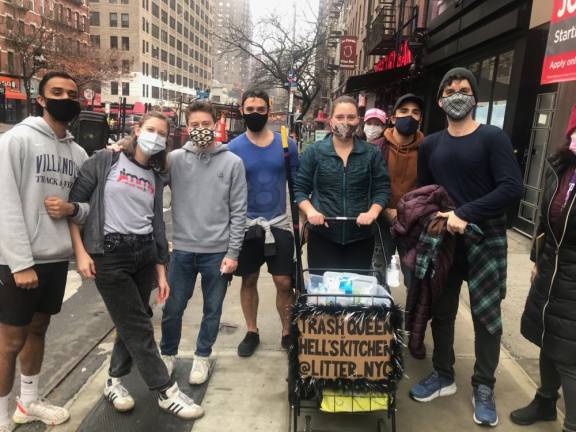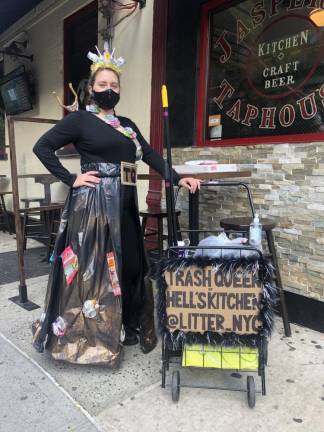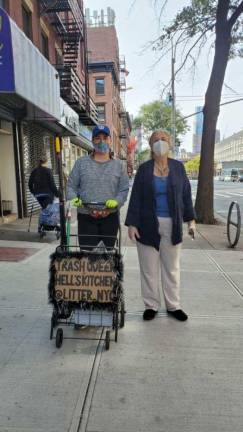The ‘Trash Queen’ of Hell’s Kitchen
Catie Savage on her mission to keep her community clean



If you’re on West 51st Street and stumble upon a laundry cart labeled “Trash Queen of Hell’s Kitchen,” Catie Savage will not be far behind, with trash bags and gloves, cleaning up her neighborhood’s streets. At the start of the pandemic, she began seeing masks and gloves negligently discarded on the ground, and as the weather got warmer and restaurants started offering drinks and food to go, she witnessed another increase in litter. This sudden influx of outdoor garbage coincided with the Department of Sanitation’s budget being decreased by a staggering $106 million dollars and corner basket service funds slashed by 67 percent.
This unpleasant garbage situation made the Central New Jersey native take the initiative to just start removing it on her own. “I collected two to three bags just on my one block in Hell’s Kitchen,” she said of her humble beginnings. After doing this single-handedly for a few weeks, she began posting on social media to see if others wanted to join her effort. At first, three or four would show up, and now the clean-up crew, that meets on Sunday mornings, has grown to as many as 25 community-minded citizens, which she dubbed the “Hell’s Kitchen Litter Legion.”
Through her literal firsthand experience, Savage, who’s a women’s luxury apparel pattern-maker, speaks to the importance of having respect for our city’s neighborhoods and the environment at large, as well as consideration for others when disposing of your garbage. She also stresses that New Yorkers should remember that our sanitation workers are not only essential, but have a dangerous and thankless job. “People just think, ‘I put my garbage on the street, and the garbage fairies come and they make it go away,’” she said. “And no one thanks them for doing it, but when the trash doesn’t get picked up, people get very upset.”
Explain how the idea came about and how social media helped spread the word.
I had actually dipped my toes into it in April of last year, when people were still mostly off the streets. I’d walk to the post office and see masks and gloves all over the place. We were having hundreds of people dying a day and sirens and the 7 p.m. clapping, and then you’d go out on the street and you’d just see masks and gloves discarded everywhere. I also volunteer with Manhattan Community Boathouse at Pier 96 that provides free kayaking, so I know that the way the city’s combined sewage overflow system works is — if we have a heavy rainstorm, especially in the spring — all of that stuff that’s on the street and collecting by the storm sewers gets washed into the sewer and gets let out into the river to avoid overflowing the treatment plants. I wanted to make sure that these gloves and masks weren’t ending up in the river, so I was primarily focused on picking up those items.
Once more people started coming outside, the litter issue became a bigger thing, so I kind of evolved and was like, “Alright, now there’s more than just masks and gloves to pick up. There’s plastic cups, those little to-go drink pouches, bottles, cans, food containers.” So I started doing that and then started posting on social media to see if anybody else wanted to meet up. I’d provide the bags and the gloves, and we would just work together to pick up as much trash as possible in the neighborhood. And I just had a backpack, kitchen trash bags and some disposable gloves, and we went to it. As it grew, I got myself a laundry cart, then made a sign, “Trash Queen of Hell’s Kitchen” with my Instagram. And that really helped, because it gave us more visibility. I had people who’d drive by in their car and would send me a message on Instagram like, “Hey, I saw you guys cleaning. How can we get involved? We live in the neighborhood.”
You’ve also created Clean-Up kits which people can pick up at certain locations in Hell’s Kitchen. What’s in them?
I currently have 10 different locations. Empanada Mama, Amy’s Bread. Sullivan Street Bakery on 47th, between 10th and 11th — it feels like it would be out of the way, but that’s probably my number one location where people have picked up kits. The kit is comprised of two trash bags and two pairs of disposable gloves and it’s wrapped with a little info sheet on what to do. So it has my Instagram handle, email address, and lets people know some best practices. If you’re picking up items near the curbs or the bike lanes, just to be really cautious of cars and bikes. Not to pick up broken glass. Unfortunately, we do encounter syringes, which is something I’ve never seen in 16 years in New York City, but it’s something that we do see now. And letting people know to be as safe as possible and avoid that. Don’t just stick your hand in a tree pit without being able to see what’s there. And then, once the bags are filled, to tie them up neatly and place them next to public litter baskets so that they can then be collected by the Department of Sanitation.
Tell us about the neighborhood cleanup groups that you partner with and the NYC Cleanup Initiative.
Just through doing this, I’ve gotten connected to a lot of other groups via social media. There’s Proud Astorian out in Astoria, Clean Up Crown Heights in Brooklyn, Renegades of Trash in Bed Stuy, Anti Litter Project in the Bronx. And we all started for the same thing, just as private citizens who, because of the pandemic and everything that was happening, we just started seeing trash on the streets and we just decided, “You know what, we could do something about this. We don’t have to just accept that this is our living situation. We can go out there and make a difference.” So I have gone to different neighborhoods and different boroughs and have helped with cleanup. We’re all working together to help push for additional funding for the Department of Sanitation and the NYC Cleanup Initiative. The Department of Sanitation picks up residential and institutional trash and recycling and they empty public litter baskets. They do not clean sidewalks or sweep up in front of vacant storefronts. That’s where the NYC Cleanup Initiative, which is a discretionary funding item, really helps, and that was also cut by 40 percent for FY21.
The mayor made some changes to garbage removal recently.
So the mayor did recently announce an increase of 100 trucks per week for litter baskets, being sent to 33 neighborhoods that were identified as the hardest hit by COVID. And that is being paid for directly by federal stimulus money. He has also recently announced the City Cleanup Corps, which will be hiring 10,000 workers that will be managed by 10 different city agencies to help with graffiti removal, power washing sidewalks, beautification, like plantings at tree plants, community garden stuff. However, all of that is stuff that’s being done immediately with federal stimulus funding. From what we saw with the FY22 preliminary budget that the mayor put out in January, there have not been any increases in service to Sanitation’s budget.
As you’re doing your cleanups, what have been some surprising items you’ve found on the street?
I don’t want to get on dog owners, but there are frequently times that they don’t attempt to even pick up after their dogs. Or if they do, they don’t actually tie the bag shut. So when we’re emptying corner baskets to make them useable, it’s frequently coffee cups and dog poop bags. And when the dog poop bags aren’t tied shut, you run the risk of that coming out. And you have to think about the sanitary aspects of it and how disease spreads and rats and all of these things. You don’t want to have that. It’s not okay. We once came across a box filled with 15 to 20 water bottles filled with various shades of urine. That was definitely interesting. We picked up a hammer one time, that was useful. We found a metal shovel that someone had thrown out.
To learn more, visit https://linktr.ee/litter_nyc
Follow Catie and the Hell’s Kitchen Litter Legion on Instagram @litter_nyc